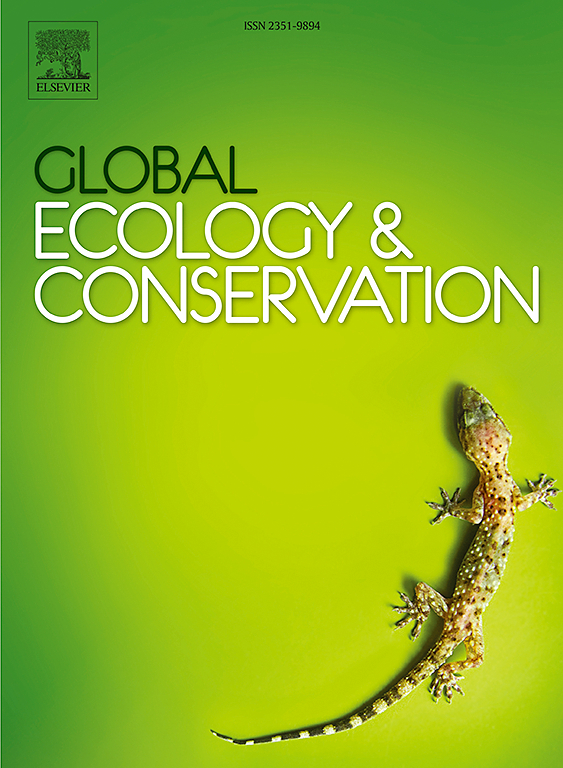Seabird moult timing and duration: Implications for at-sea threat exposure worldwide
IF 3.5
2区 环境科学与生态学
Q1 BIODIVERSITY CONSERVATION
引用次数: 0
Abstract
Tubenosed seabirds (order procellariforms) are the most threatened bird group. Threats generally act on two distinct elements of their life-history, either breeding at terrestrial colonies, or during the nonbreeding season while at sea foraging and migrating. Moult is often overlooked as another critical life-history component that can determine their vulnerability and exposure to threats at sea. Using 13,092 geo-referenced citizen-science photographs from publicly available and private collections, we scored primary feather moult for 6 gadfly petrel species (Pterodroma spp.) as a representative and understudied group of tubenosed seabirds. To investigate environmental conditions of areas where gadfly petrels moult, we quantified moult phenology for 1336 individuals. Moult activity overlapped with breeding and/or migration in all species, a surprising result, as these processes are temporally offset in many other birds. Sea surface temperature predicted moult activity in most species, with the probability of active moult being greater in areas with higher sea surface temperatures. Higher sea surface temperatures are associated with lower marine productivity, so gadfly petrels undergo moult in less productive waters than they occupy at other times. This possibly reflects avoidance of adverse conditions that disproportionately affect gadfly petrels with compromised plumage. Our findings indicate that moult is important for understanding tubenosed seabird distributions, and affects exposure to substantial threats. Knowledge of how moult informs threat exposure can refine best-practice in conservation planning for seabirds, by informing key management tools such as designating marine protected areas.
海鸟换羽的时间和持续时间:对全球海上威胁暴露的影响
管状海鸟是最受威胁的鸟类群。威胁通常发生在它们生活史的两个不同的因素上,要么是在陆地栖息地繁殖,要么是在海洋觅食和迁徙的非繁殖季节。换毛作为另一个重要的生活史组成部分,往往被忽视,它可以决定它们在海上的脆弱性和暴露程度。利用来自公共和私人收藏的13,092张地理参考的公民科学照片,我们对6种牛虻海燕(Pterodroma spp.)的初级羽毛蜕皮进行了评分,牛虻海鸟是一个代表性的和未被充分研究的群体。为了解牛虻蜕皮地的环境条件,对1336只牛虻的蜕皮物候进行了定量分析。所有物种的换羽活动都与繁殖和/或迁徙重叠,这是一个令人惊讶的结果,因为这些过程在许多其他鸟类中是暂时抵消的。海洋表面温度预测了大多数物种的换羽活动,在海洋表面温度较高的地区,活跃换羽的可能性更大。较高的海面温度与较低的海洋生产力有关,因此牛虻在生产力较低的水域进行换毛,而不是在其他时候。这可能反映了对不利条件的回避,这些不利条件不成比例地影响了牛虻海燕的受损羽毛。我们的研究结果表明,蜕皮对了解管状海鸟的分布很重要,并影响暴露于实质性威胁。了解蜕皮如何通知威胁暴露,可以通过通知关键管理工具(如指定海洋保护区),改进海鸟保护规划的最佳做法。
本文章由计算机程序翻译,如有差异,请以英文原文为准。
求助全文
约1分钟内获得全文
求助全文
来源期刊

Global Ecology and Conservation
Agricultural and Biological Sciences-Ecology, Evolution, Behavior and Systematics
CiteScore
8.10
自引率
5.00%
发文量
346
审稿时长
83 days
期刊介绍:
Global Ecology and Conservation is a peer-reviewed, open-access journal covering all sub-disciplines of ecological and conservation science: from theory to practice, from molecules to ecosystems, from regional to global. The fields covered include: organismal, population, community, and ecosystem ecology; physiological, evolutionary, and behavioral ecology; and conservation science.
 求助内容:
求助内容: 应助结果提醒方式:
应助结果提醒方式:


